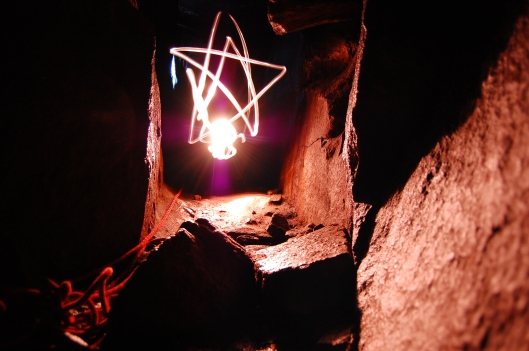The idea that the vowels hold the secret to some mystical, primal language appears to have a genuinely ancient lineage. Notably they seem bound up with the ritual expressions of the Gnostics. For example, in the Nag Hammadi codices we find a Hermetic dialogue entitled The Discourse on the Eighth and Ninth. As in some of the dialogues of the Corpus Hermeticum (XI & XIII), the master in this dialogue also breaks from philosophical and theological speculations to sing: as though poetry, sound and music may provide the pupil with another route to divine experience alongside meditation and philosophical instruction. What is interesting about the hymns in the Nag Hammadi codex is their peculiarly Gnostic character:
“Grace! After these things, I give thanks by singing a hymn to you. For I have received life from you, when you made me wise. I praise you. I call your name that is hidden within me:
A O EE O EEE
ooo iii oooo
ooooo
ooooo uuuuuu oo
ooooooooo
ooooooooo
oo.
You are the one who exists with the spirit. I sing a hymn to you reverently.”
The vowels are the elemental parts of speech – without which (as Joscelyn Godwin points out) our language would consist of clicks and hisses. With this in mind, it is not surprising that in the syncretistic antique magical imagination vowels are perhaps otherworldly signifiers of primal, celestial and inhuman powers, as in the ritual known as the Mithras Liturgy:
I invoke the immortal names, living and honored, which never pass into mortal nature and are not declared in articulate speech by human tongue or mortal speech or mortal sound: EEO OEEO IOO OE EEO EEO OE EO IOO OEEE OEE OOE IE EO OO OE IEO OE OOE IEO OE IEEO EE IO OE IOE OEO EOE OEO OIE OIE EO OI III EOE OYE EOOEE EO EIA AEA EEA EEEE EEE EEE IEO EEO OEEEOE EEO EYO OE EIO EO OE OE EE OOO YIOE.
In more recent times, the sounding of vowels and particularly the related practices of overtone singing have captured the imaginations of composers and musicians – notably Stockhausen in his Stimmung:
And, roughly contemporary with Stockhausen’s work, the vocal improvisation group Prima Materia who practiced communal singing meditations which also involved members of the public:
I’ve been entranced by the vowels and the practice of improvising with them for some time – although less in the overtone-influenced manner than groups like Prima Materia. Akin to Pauline Oliveros and her Tuning Meditation, I have found these deceptively simple elements of sound possess a potent way to bring a group of people together and to interact with with them in a purely tonal and emotional way, unfettered by the expectations of either spoken or musical language. Wordless vocalisations had appeared on my music from the earliest recordings and seemed natural to me: if I was making music which, as I perceived it, as born of a conversation between soul and nature, then wordless sounds seemed more appropriate than human speech.
I have some fond memories of singing with my friend Rhid Williams in an abandoned lead mine in Wharfedale, and also exploring the vowels a little on the second Pneumatic Consort album. The first group recordings were made as part of the Almias project with Simon Bradley and Layla. We sat in a couple of the natural stone shelters at the foot of the Almscliffe Crag and began to improvise. The utterance of god names also made an appearance in these recordings, partly s a tribute to Stockhausen’s Stimmung, and in reference to some of the ideas that were circulating among the group as a result of the psychogeographic work we were doing there. Here’s one of the recordings:
When I was asked to put something together for a Bang the Bore event about the human voice a year later, my thoughts again turned to vowel singing and particularly the magical associations that have historically accompanied the vowels. Working with Seth Cooke, Sara Sowah and Layla, the following template for an improvisation evolved:
Orphic Prayer
0. Each participant writes down a secret statement of intent.
1. Remove the consonants and keep the vowels.
2. Associate one or more relevant godforms with the statement of intent.
3. Ring a bell.
4. Each participant works through their vowels at their own pace, harmonising or falling out of harmony and rhythm with the others. Once the series of vowels have been exhausted, repeat them.
5. At appropriate intervals, the bell is struck. This is the signal for the rightmost participant to begin introducing the names of godforms into his/her vocalisations as desired. Each time the bell is struck, another participant may begin to vocalise their godform.
6. In private performance, keep going until you ‘make it’. An audience, however, may be more restless. Make what you can of your own adrenaline/endorphins and finish with a song to please them.
You can listen below: it sounded pretty good… and did the our statements of intent work themselves into reality? Well, I don’t want to jump to conclusions, but it seems they all did!


